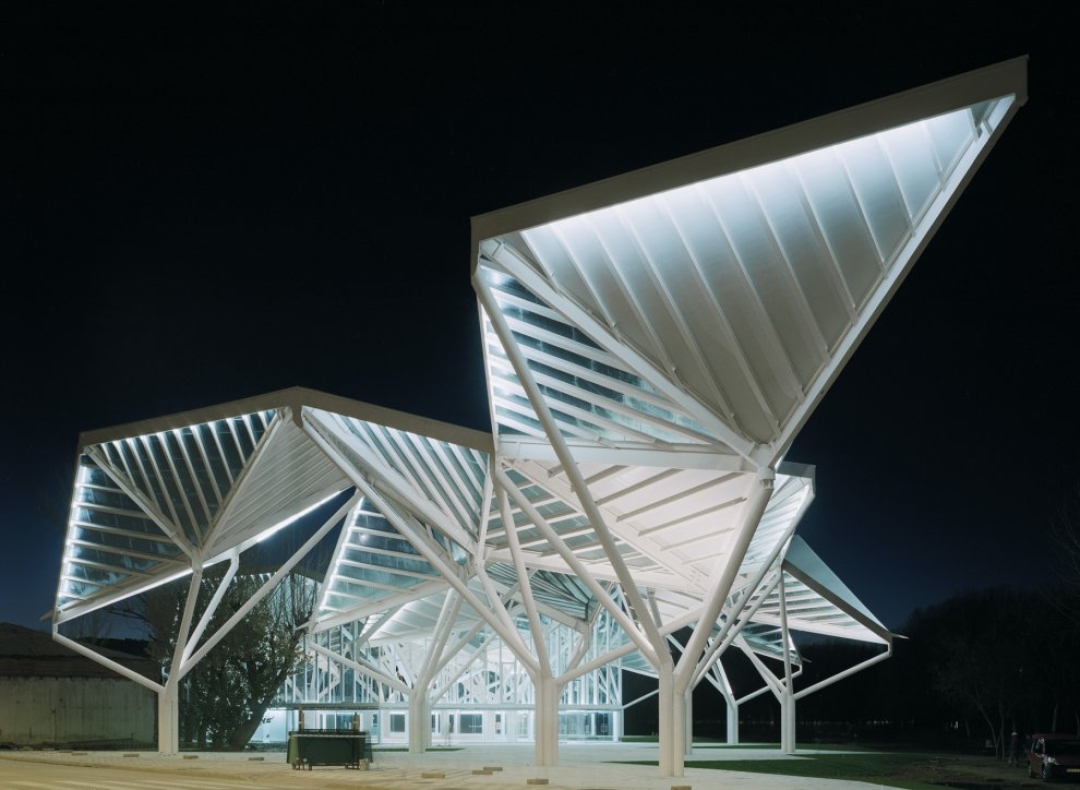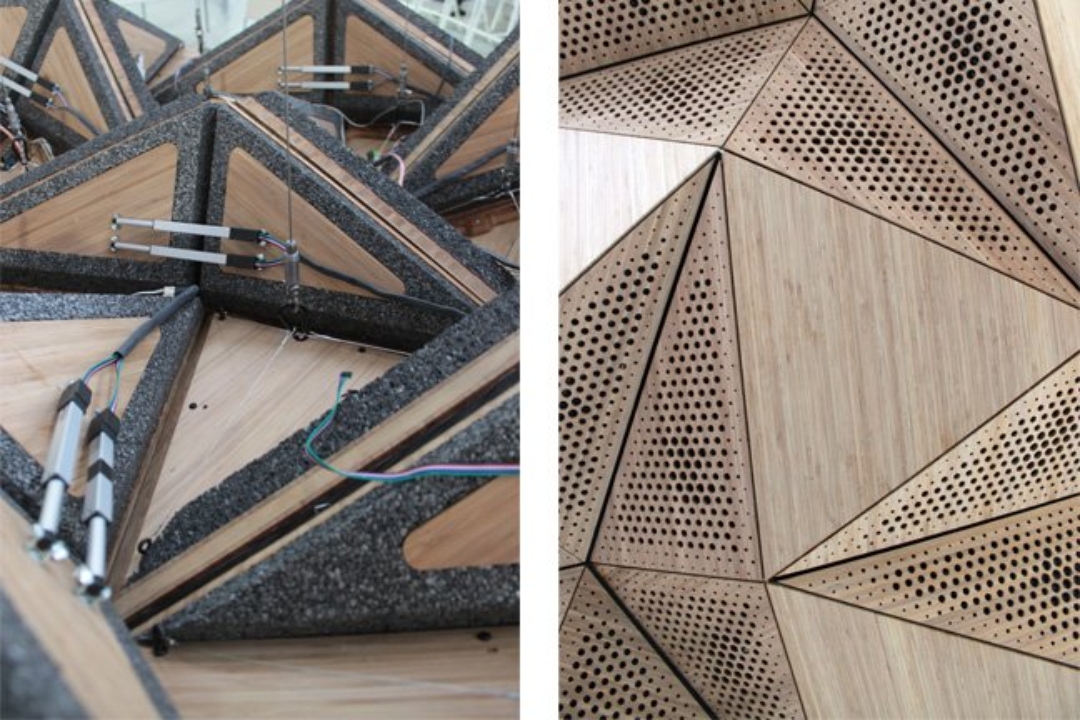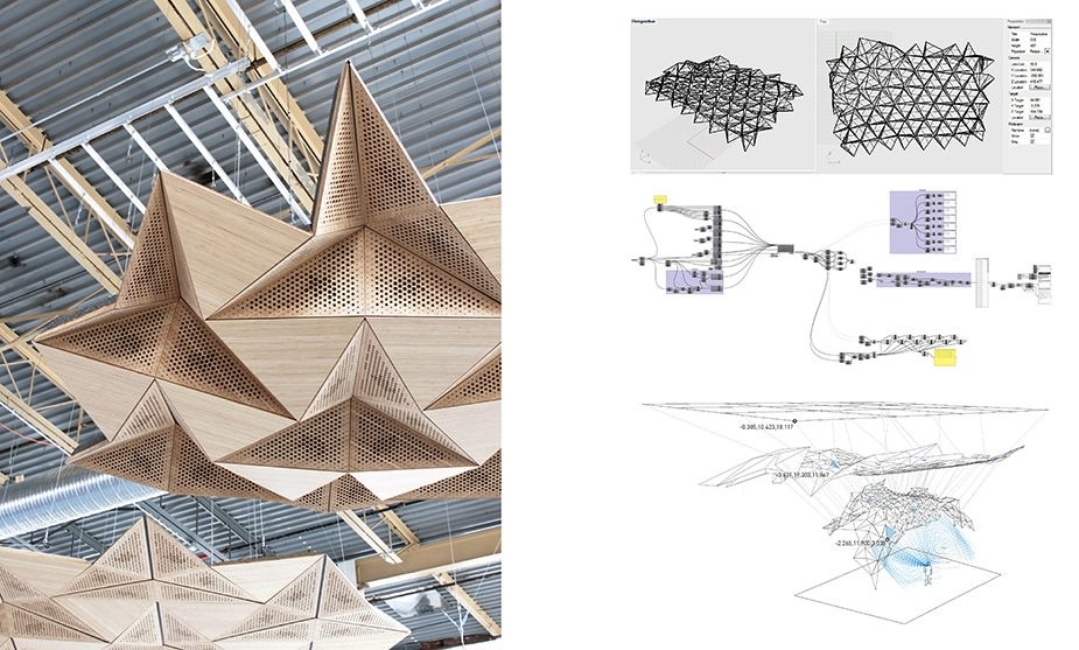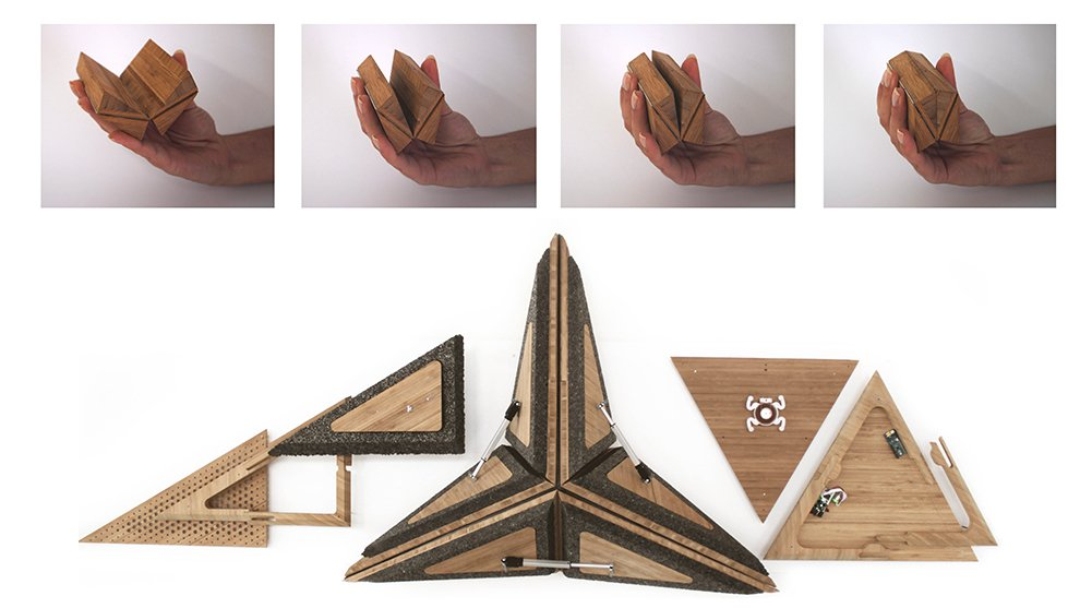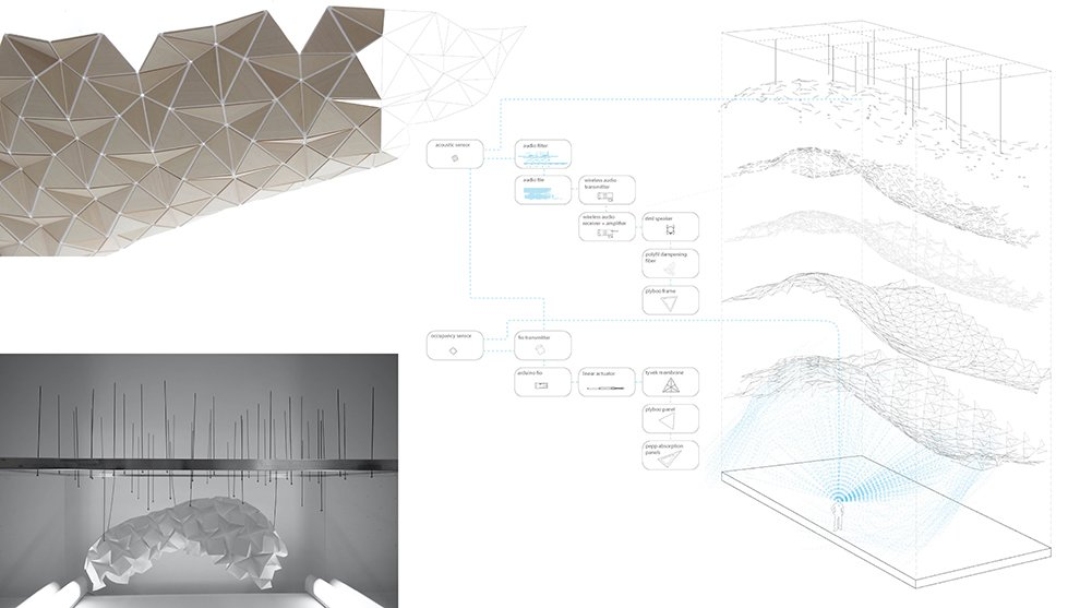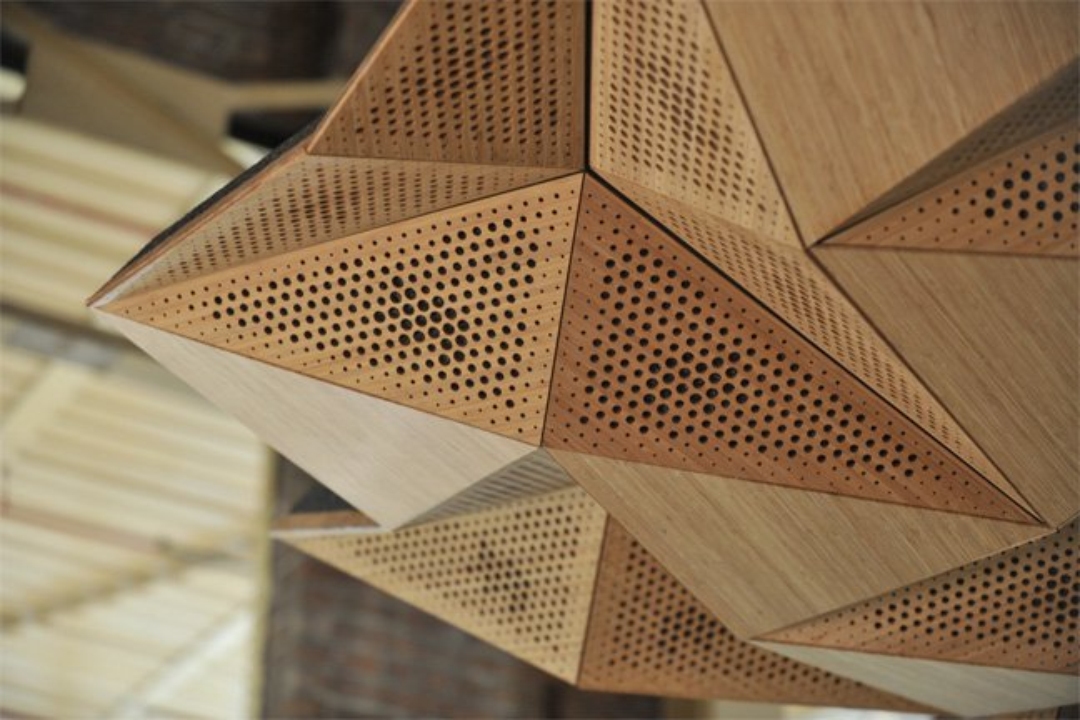Origami Benefit and Application 3
فایده و کاربردهای اوریگامی
Origami Robots Run Only on Air
- February 9, 2012 |
- 2:38 pm |
- Categories: Tech

Powered by nothing more than puffs of air, robots molded from paper and silicone rubber can bend, twist, grip and even lift more than 100 times their weight.
The pneumatic prototypes aren’t as advanced as their metallic brothers, and the “soft” robots contain no electronics yet. But their creators, funded by Darpa, imagine applications where a soft-bot might be the best tool.
“If you want to go through a winding tube or rubble or some other tough environment that’s difficult to reach, you need to be flexible,” said chemist Xin Chen of Boston University, member of a team who describes their work in a Feb. 9 Advanced Functional Materials paper. “Soft robots can go a lot of places where hard robots cannot go.”
Robots crafted from metal or other hard materials, filled with electronics and powered by electricity are the mainstays of robotics. They can build cars, carry heavy equipment and even defuse bombs. Yet in some environments, flexibility is crucial.
As a result, engineers have looked to nature for ideas, with models inspired by insects, birds, snakes, fish and even dogs. Whitesides and his team have already developed air-powered rubber robots that can constrict like snakes and undulate under obstacles (video below).
Their new work takes the soft robots a step further by incorporating paper, fabric and wire mesh to add strength and definition to silicone-molded shapes. After they’re molded, the devices are hooked up to a simple compressed air source, such as a syringe.
 Getting
the soft robots to perform a particular action is a feat of origami:
Folded in just the right way and glued in the right spots, for example,
the researchers showed how a crinkled clump of silicone-soaked paper
lifted a 2-pound weight. The force of the air required to drive it was
roughly twice that of a human exhalation.
Getting
the soft robots to perform a particular action is a feat of origami:
Folded in just the right way and glued in the right spots, for example,
the researchers showed how a crinkled clump of silicone-soaked paper
lifted a 2-pound weight. The force of the air required to drive it was
roughly twice that of a human exhalation.The team has also cylinders that blow into spheres, tubes that act like springs and compact stacks that turn into rigid rings or pipes.
In the future, the researchers hope to add wiring and electronics to bring even more functions to their forms.
The military is interested in such robots as weapons or spying devices, but beyond battlefields the researchers also envision shrinking their creations.
“In principle, you could scale down to microscopic or nanoscopic scales,” Chen said. “You can’t do the same with hard materials.”
Images: Ramses V. Martinez et al./Advanced Functional Materials 1) Glued in the right places (dotted lines) and filled with air, a silicone-soaked piece of paper can take on highly specific shapes. 2) A paper robot bellows lifts 120 times its own weight.
Video: GMWGroupHarvard/YouTube
Citation: “Elastomeric Origami: Programmable Paper-Elastomer Composites as Pneumatic Actuators.” By R. V. Martinez, C. R. Fish, X. Chen and G. M. Whitesides. Advanced Functional Materials. Published online Feb. 9, 2012. DOI: 10.1002/adfm.201202978
River Island Origami Dress
We are all feeling the tug at our collective purse strings at present and, sadly, those pretty vintage reproduction dresses don't tend to come cheap. Thankfully, occasionally the good old High Street can be relied upon to turn up with the goods. The particular goods in this case being this rather fetching Origami Dress from River Island.
Decor by Droid: RoboFold is practising origami with aluminium
By Matt Hussey
08 February 12

Interior design doesn't usually call for industrial robots. But who says you can't mechanise home decor? RoboFold founder Gregory Epps, 32, has been folding metal since he was a teenager.
"The idea of industrialising folding metal started about 16 years ago," he says, "but it wasn't until 2008 that I turned it into a business." His patented process uses six machines normally found in car manufacturing plants. They gently bend sheets of aluminium into shapes hard to achieve through conventional methods, to create decorative facades for interiors. The south London-based company uses computer-aided design to develop a 3D model. The bots look after the rest.
"We're looking to introduce a range of products and designs you could attach to a wall in an office, hotel or even your home," he says. Now, where's that bathroom mirror?
روبات اوریگامی: فقط کاغذ و هوا
چارلی آزبورن | فوریه 10، 2012، 4:25 AM PST
0Comments
اطلاعات بیشتر +
گروهی از پژوهشگران دانشگاه هاروارد گرفته اند طراحی
روبات و حتی بیشتر - با ایجاد ماشین هایی که بر اساس خواص کاغذ، و قادر به اجرا بر
روی چیزی جز هوا.
این روبات از کاغذ و لاستیک سیلیکون قالبگیری شده
اند و با بیان هدف از انجام وظایف سخت، روبات می تواند ایجاد شده اند. اگر چه نمونه
های مدارات الکتریکی شامل نشده است، پژوهشگران امیدوارند که خود را "نرم"
طراحی ربات - که قادر به خم، خم شدن، پیچ و گرفتن - در به کارگیری آن در حالات که نیاز
به دوام الکترونیکی پیچیده نه لزوما به دست مفید خواهد بود اما سخت، طرح.
با توجه به پژوهش، 'نرم افزار' روبات همچنین قادر
به بلند کردن 100 برابر وزن خود را.
رهبری توسط پروفسور جورج وایتسایدز، تیم کاغذ در
درون ماده سیلیکون هوا تنگ الاستیک محصو ر، با اشاره به عنوان "لاستیک سیلیکون.
در یک طرف کاغذ، کانال های هوا کوچک نفوذ طراحی، اجازه می دهد از مواد لاستیکی خم شدن
و زمانی که هوا را از طریق راه های هوایی پمپ.
پژوهشگر رامسس مارتینز مقایسه ساختارها به بالن:
"هنگامی که بخشی از بالون از ساختار گسترش
می یابد، آن را نشانی از تبدیل به گرد (کند بالون کودک)، اما شکل های پیچیده تر در
واکنش به محدودیت های اعمال شده توسط ورق کاغذ را تصویب می کند."
برای مثال، افراد شاغل در خطوط مونتاژ - در محیط
های که در آن انعطاف پذیری از توابع مانند انجام وظایف سنگین وظیفه فوری تر است، این
تحقیق می تواند کمک به تعدادی از وظایف مناسب برای رباتیک جریان اصلی بیشتر فراهم کند.
دکتر مارتینز معتقد است که این می تواند تو رفتگی در دیوار که طرح این تیم را پر کنید:
"ما امیدواریم این ساختارها را می توان به
دستیاران برای انسان است. بر خلاف نوع (ماشین ها) ربات های مورد استفاده در خطوط مونتاژ
(که طراحی شده است که بسیار قوی و سریع است، اما آنها نیز بسیار خطرناک برای انسان
به وقتی آنها عامل)، این محرک می تواند بیشتر انسان دوستانه است.
آنها ممکن است، بنابراین، ارائه انگشتان اضافی
یا دست برای جراحان، و یا ساختار به راحتی آسیب دیده می شود، از قبیل تخم مرغ یا میوه
را اداره کند. "
در فرایند شبیه به اوریگامی، حرکت و اشکال پیچیده
را می توان با تغییر جریان هوا با هدف در این روبات های نرم ایجاد شده است. دانشمندان،
اندازه گیری الهام از حرکات حیوانات انعطاف پذیر مانند ستاره های دریایی و ماهی مرکب
در زمان - اما وسیله ای برای استفاده از هوا به جای عضلات برای ایجاد سطوح مشابهی از
انعطاف پذیری.
Las Vegas Chamber of Commerce Uses Origami Folding Card with QR Code to Promote Preview 2012
Las Vegas Chamber of Commerce had a challenge. How to get its message noticed. They turned to Jammie Hsu of Proforma Element 7 who helped them create an interactive card manufactured by Wall Printing Company. The card creates a never ending loop, which really stood out and the QR code sent them to the website for more information.
Las Vegas, NV (PRWEB) February 09, 2012
Las Vegas, the city that screams for attention. How do you get your
message noticed above the noise in Las Vegas? That is what the Chamber
of Commerce was trying to decide when they turned to Jammie Hsu with Proforma Element 7. She recommended the interactive card by Wall Printing.This unique card has four panels that capture attention, even in Las Vegas. The card included a QR code that provided more information instantly to people with smart phones. The card initially looks like a regular postcard, but upon opening it chamber members quickly found that it was unlike any postcard they had seen before. It is one of the most creative marketing ideas I've seen commented one member.
The interactive card has been used in a number of very creative ways over the past year. Beer companies such as Guiness and Samuel Adams have used it as an interactive coaster and companies of all sizes have found it to be a unique way to get their message out. It is even becoming popular as a business card and brochure all tied into one piece.
About Proforma Element 7. Proforma Element 7 provides promotional products, printing services, business documents, ecommerce solutions and multimedia solutions and is located in Las Vegas NV.
Wall Printing produces innovative print products and works through distributors throughout the United States. They have also partnered with Memory Cross to create educational pieces that help children learn how to live healthier lives, teach them their ABCs, Share the Gospel and teach children Bible Stories.
Learning origami the fun way |
|
| By Aanya Wipulasena | |
Origami is a traditional Japanese paper craft. Ori
which stands for ‘folding’ in Japanese and Kami for ‘paper’ together
makes the word Origami. This art has been handed down from parent to
child for many generations. Models like animals, birds, fish, geometric
shapes, puppets, toys and masks are made in origami by folding paper.
The Japanese embassy and the Japan Foundation in collaboration with the Origami Folders’ Association of Sri Lanka held an origami workshop and demonstration of Japanese paper folding on January 30 at the Sri Lanka Foundation Institute auditorium to commemorate the 60th anniversary of the establishment of diplomatic relations between Japan and Sri Lanka. The Origami Folders Association of Sri Lanka is the only recognized authority for origami promotion in Sri Lanka. This Association consists of well trained and creative origami folders who are keen to popularise origami as an international hobby throughout Sri Lanka. The workshop and demonstrations were conducted by origami artist and Director of the Nippon (Japan) Origami Association Toshinori Tanaka and Akiko Yamanashi and Shoko Aoyagi who are member tutors of the Nippon Origami Association. They were sent to Sri Lanka by the Japan Foundation especially for this workshop. Many origami lovers from across Sri Lanka and tourists attended this workshop. Each participant was handed some coloured papers and books with instructions on how to make an origami creation. “I came with my five children and we are enjoying the programme very much,” said Siri who is visiting Sri Lanka for the first time from Australia. Her eldest daughter Aelysh said that she and her siblings learnt a lot from the workshop and were going to try it at home. Students who learn Japanese at schools had come with their teachers to try their hand at origami. “It’s very interesting. We learnt a little about it in our school but learnt more at the workshop. The demonstrations were done well and we loved doing it too,” said Kanishka who had come with his friends. |
Winged Robot Is Time Machine to Origins of Flight
- October 18, 2011 |
- 11:30 am |
- Categories: Biology, Tech

By John Bohannon, ScienceNOW
Here’s what we know about the evolution of flight: By about 150 million years ago, the forests were filled with flying — or perhaps just gliding — dinosaurs like Archaeopteryx, possibly similar to the ancestor of modern birds. What we don’t know is what primitive wings were used for before bird ancestors could fly. A study published today in the journal Bioinspiration & Biomimetics provides some fresh data for this debate, not from fossils but a winged robot.
 There are two main theories for how avian flight evolved. According to the “trees-down” theory, primitive wings were used to glide down from heights. The “ground-up” theory holds that bird ancestors used their wings to “run flap”
along the ground, making them faster and better able to scamper up
steep inclines that got in their way. The problem with the ground-up
theory is the huge speed required to achieve liftoff. By comparison,
incremental improvements in gliding could have led to flight. The fossil
evidence has been too scant to settle the matter.
There are two main theories for how avian flight evolved. According to the “trees-down” theory, primitive wings were used to glide down from heights. The “ground-up” theory holds that bird ancestors used their wings to “run flap”
along the ground, making them faster and better able to scamper up
steep inclines that got in their way. The problem with the ground-up
theory is the huge speed required to achieve liftoff. By comparison,
incremental improvements in gliding could have led to flight. The fossil
evidence has been too scant to settle the matter.Ronald Fearing and Kevin Peterson, engineers at the University of California, Berkeley, were not thinking about this debate when they created a 25-gram robot called DASH+Wings. It was a modification to a tiny six-legged robot called DASH, for Dynamic Autonomous Sprawled Hexapod — one of the many robots they have developed as sneaky reconnaissance for the U.S. military and other applications. Tiny ground-based robots often have difficulty getting up inclines and over objects, Fearing says, so “we had been working on exploring a hybrid locomotion mode, where flapping wings and legs combine to propel the robot.” Once they had added wings to DASH, they realized that it might be a useful tool for settling evolutionary questions. So they teamed up with Robert Dudley, a paleobiologist also at Berkeley.
The team ran DASH+Wings through a series of mini-Olympic events. The bot ran as fast as possible across the floor. It tried to clamber up increasingly steep ramps. And it also jumped from a platform to glide as far as possible from the base. For each of these events, the team compared the bot’s performance both with and without wings, and with its wings flapping or still, all while measuring performance with accelerometers and cameras.
Having a pair of flapping wings helped with every test, but especially for gliding. Flapping wings did allow the bot to climb up steeper inclines, and it increased its running speed, but only by 90 percent, far from the 400 percent theoretically necessary for flight. In the gliding test, flapping wings allowed the bot to sail even farther from the base than it did with the wings fixed. “This result lends indirect support to the theory that avian flight evolved from tree-dwelling animals and not from land animals that required ground-based running takeoffs,” Peterson says.
“This study is a beautiful example of how relatively simple bioinspired robots can address [questions] that are difficult or impossible to test in living organisms,” says Brandon Jackson, an evolutionary biologist at the University of Montana, Missoula. The results support the gliding model, but it’s still possible that ground-based bird ancestors ran fast enough to take off, Jackson says. “The question of avian flight origins is far from answered.”
This story provided by ScienceNOW, the daily online news service of the journal Science.
Image: Adding flapping wings to this robot increased its running speed and also its gliding ability. (Kevin Peterson/UC Berkeley)
Talbot teacher uses origami to teach math principles
Fall River —
The art of folding paper into shapes like flowers and birds can also be “folded” into a math lesson.
Just ask Edmund Talbot Innovation Middle School eighth grade math teacher Benjamin Coleman, who took the time during a recent after-school extra help session with students to provide an example.
A square piece of paper can be used to demonstrate square roots. It can be folded into four and 16 squares. The square root of 16 is four.
Coleman had four students that day who were staying after school for help on graphs.
One student had a question regarding a graph on a sheet of paper in front of him: “What’s the origin?” he asked Coleman.
Coleman leaned over and pointed to the graph’s middle and explained, “That’s the center of the graph.”
Coleman is in his first year teaching at Talbot, but has been a longtime origami aficionado. He took the art of folding paper to a new level about seven years ago.
At the time Coleman was teaching in Middleboro; however, health issues forced him to take time out of work. The time off gave him plenty of time to experiment, and clear his head.
“I was laid up from surgeries. It allowed me to sort of get out of myself,” said Coleman.
Coleman said he was in the process of folding what he described as “a really cool eagle,” when he discovered a new folding pattern.
That led to writing books, starting with “Origami Bonsai.” To date, Coleman has written three books. He sells those books and origami kits to hobbyists around the world.
“Origami is really big in Indonesia, and Sao Paolo, Brazil, of all places,” said Coleman. “I’m sending tons of books there.”
In origami circles Coleman has garnered some acclaim. In 2009, he was interviewed on the National Public Radio program “Studio 360.” During the program he discussed how to create lifelike foliage. One technique involves treating and rolling newspapers in such a way as to recreate tree branches.
Coleman showed off the patent for the folding pattern he created. He just received it. The process of obtaining a patent involved furnishing numerous documentation and fees. Needless to say, it took a while.
Coleman said he started teaching in the early 2000s, shortly after the computer company he had founded, called Gigabyte, closed. A Providence native, Coleman said he started teaching on Saturdays, for the College Crusade program in Pawtucket, Providence and Central Falls, R.I.
He said he’s also taught in suburban schools, but he was the product of an urban school environment and feels most at home in an urban classroom. Coleman said his was a difficult learning environment. He didn’t have “real” math teachers in high school; there was a shortage of qualified teachers.
Just ask Edmund Talbot Innovation Middle School eighth grade math teacher Benjamin Coleman, who took the time during a recent after-school extra help session with students to provide an example.
A square piece of paper can be used to demonstrate square roots. It can be folded into four and 16 squares. The square root of 16 is four.
Coleman had four students that day who were staying after school for help on graphs.
One student had a question regarding a graph on a sheet of paper in front of him: “What’s the origin?” he asked Coleman.
Coleman leaned over and pointed to the graph’s middle and explained, “That’s the center of the graph.”
Coleman is in his first year teaching at Talbot, but has been a longtime origami aficionado. He took the art of folding paper to a new level about seven years ago.
At the time Coleman was teaching in Middleboro; however, health issues forced him to take time out of work. The time off gave him plenty of time to experiment, and clear his head.
“I was laid up from surgeries. It allowed me to sort of get out of myself,” said Coleman.
Coleman said he was in the process of folding what he described as “a really cool eagle,” when he discovered a new folding pattern.
That led to writing books, starting with “Origami Bonsai.” To date, Coleman has written three books. He sells those books and origami kits to hobbyists around the world.
“Origami is really big in Indonesia, and Sao Paolo, Brazil, of all places,” said Coleman. “I’m sending tons of books there.”
In origami circles Coleman has garnered some acclaim. In 2009, he was interviewed on the National Public Radio program “Studio 360.” During the program he discussed how to create lifelike foliage. One technique involves treating and rolling newspapers in such a way as to recreate tree branches.
Coleman showed off the patent for the folding pattern he created. He just received it. The process of obtaining a patent involved furnishing numerous documentation and fees. Needless to say, it took a while.
Coleman said he started teaching in the early 2000s, shortly after the computer company he had founded, called Gigabyte, closed. A Providence native, Coleman said he started teaching on Saturdays, for the College Crusade program in Pawtucket, Providence and Central Falls, R.I.
He said he’s also taught in suburban schools, but he was the product of an urban school environment and feels most at home in an urban classroom. Coleman said his was a difficult learning environment. He didn’t have “real” math teachers in high school; there was a shortage of qualified teachers.
Read more: http://www.heraldnews.com/newsnow/x529845068/Talbot-teacher-uses-origami-to-teach-math-principles#ixzz2jhG2w6Zu
Follow us: @Hnnow on Twitter | HNNow on Facebook
Folding Architecture: Top 10 Origami-Inspired Buildings
Architects love origami because it achieves what buildings rarely do: frame space through extreme economy of means. Origami artists can produce a panoply of shapes and forms using only a single sheet of paper. Their constructions are inherently structural and can even be engineered to bend, contract, and expand---things that buildings can't do either.
Festival Hall of the Tiroler Festspiele Erl
Erl, Austria
Tel Aviv Museum of Art
Tel Aviv, Israel
Photo: Paúl Rivera
Nestlé Chocolate Museum
Murcia, Spain
Photo: John Gollings
Klein Bottle House
Rye, Victoria, Australia
Photo: Ake Lindman
Park Pavilion
Cuenca, Spain
Karuizawa Museum Complex
Nagano, Japan
Shanghai, China
Centre for Sustainable Energy Technologies
Ningbo, China
Barcelona, Spain
Origami In Stereo: Welcome To The Sound Cloud!
The drawback of even the best acoustic setup is that walls and ceilings don't tend to move. Three designers at the research practice RVTR—Geoffrey Thün, Wes McGee, and Kathy Velikov—decided to change all that by harnessing the visual art of origami to direct sound with greater precision. Like a giant shape-shifting speaker, RVTR's prototype responds to sensor data and optimizes its position based on a range of inputs, from acoustic goals to the movements of listeners below. The prototype, called Resonant Chamber, won over our A+ Award judges and our readers, taking both the Jury Award and the Popular Choice Award. Acoustics never looked so good!
In collaboration with Arup, the designers developed three origami-style "sound clouds" and installed them at the University of Michigan's Taubman College of Architecture last year. "Our aim is to develop a soundsphere able to adjust its properties in response to changing sonic conditions, altering the sound of a space during performance and creating an instrument at the scale of architecture, flexible enough that it might be capable of being played," writes the team at RVTR, which has offices in Toronto and Ann Arbor, Michigan.
Each cloud functions as a three-in-one system, thanks to triangular composite panels that serve different functions. Solid plywood panels reflect sound; perforated panels with polypropylene inserts absorb sound; and hollow panels, which are outfitted with electronics, basically turn the panel faces into speakers. "One of the goals of this project was to develop a common system of assembly that could deliver a panel relatively standardized in form," say the designers.
The origami approach opens up a lot of possibilities. Because of its flexibility, Resonant Chamber could be affixed to walls or function as a soffit. But, the designers explain, "we have been imagining a vast surface that can be contracted to the position of a soffit and then selectively draped to provide enclosure." Later this year they will work on the control system and try out a new iteration of the chamber's design.
Such a targeted, tunable acoustic system has a wide range of applications, from recalibrating performance spaces based on the number of occupants to improving listening conditions for a hearing-impaired audience. Plus, it gives all of us acoustically clueless, hypervisual folks a chance to see sound in motion.




